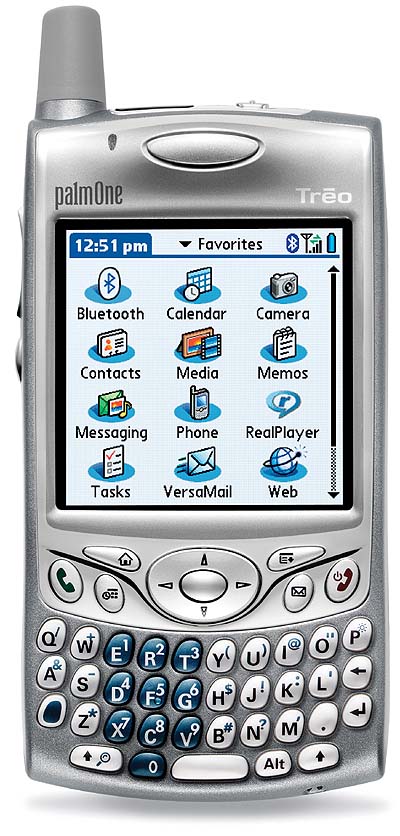

Current Cover
|
|
|
|
|
|
Palm Treo 650Palm fixes (almost) all the errors and omissions that plagued the original Handspring Treo 600 In almost every respect, the original Treo 600 got everything right. With it, Handspring gave us a smartphone that really deserved its name. It was both an excellent phone and an excellent Palm OS device, and Handspring did a bang-up job in integrating the two functions. In our December 2003 issue, we actually called the Treo 600 a "phone with a built-in PDA." That's how close Handspring came to putting everything into a small 7 ounce device that was barely larger than your average cellphone of late 2003. The Treo even had a built-in digital camera and there were both a GSM and a CDMA version, making the device usable with a wider variety of providers and services. In 2003, little "RIM-style" thumbtype keyboards were all the rage, and we liked the one on the Treo 650. It was a bit weird to have a touchscreen, but no handwriting recognition, but we got used to it. In almost every respect, the original Treo 600 got everything right. With it, Handspring gave us a smartphone that really deserved its name. It was both an excellent phone and an excellent Palm OS device, and Handspring did a bang-up job in integrating the two functions. In our December 2003 issue, we actually called the Treo 600 a "phone with a built-in PDA." That's how close Handspring came to putting everything into a small 7 ounce device that was barely larger than your average cellphone of late 2003. The Treo even had a built-in digital camera and there were both a GSM and a CDMA version, making the device usable with a wider variety of providers and services. In 2003, little "RIM-style" thumbtype keyboards were all the rage, and we liked the one on the Treo 650. It was a bit weird to have a touchscreen, but no handwriting recognition, but we got used to it.
Unfortunately, Handspring did make a few design decisions that rendered the Treo 600 less useful than it could have been: Its 144 MHz Texas Instruments OMAP processor was a big improvement over earlier Treos, but it wasn't nearly as quick as some of the Tungstens. While the Treo had a rather powerful 1,800mAH battery that we considered quite adequate, it still only provided something like four hours of talk time. Which meant a lot of people wanted a spare. Problem was that the Treo 600's internal battery couldn't be replaced and so you need a big, bulky external battery. Lots of folks were looking forward to using their Treo as a wireless modem for a notebook. No can do, and no Bluetooth. While the internal 640 x 480 pixel digital camera was a nice touch (and almost a must for a modern smartphone), it was near useless indoors. And worst of all, whoever decided to stick the Treo 600 with a murky, low-res 160 x 160 pixel display just didn't get it. High tech and low res don't go together. All of the above combined to make the Treo 600 one of those "this is really great but..." devices and earned it just a "B" rating in our initial review. Well, we're happy to report that with the new Treo 650, palmOne has fixed almost everything that was wrong with the Treo 600, and then some. They didn't really have to make the Treo faster, but they did. The 650 has a state-of-the-art 312 MHz Intel PXA 270 chip. The battery is now removable so you can carry along a spare and pop it in when you need it. That's a much better solution than a clunky snap-on battery. The camera is still "only" 640 x 480, but it now takes much better pictures in low light. There's also a 2X digital zoom, and you can take movies. We had no major problem with the Treo 600's keyboard, but the new one is definitely better. It's a backlit affair with slightly larger and flatter keys that make typing easier. The layout also has subtly changed, for the better, and there are new "send" and "end" buttons. We really missed Bluetooth on the Treo 600. The 650 has Bluetooth and you can use it to connect a notebook to the Internet. There still isn't a lot of memory, just 23MB for the user, but it's non-volatile now, which means you'll never lose your data even if the battery goes dead. Yeah! You can now listen to MP3 music via the built-in MP3 player. However, to do so you need an expansion card. And the biggest news of all: the screen is now 320 x 320 pixels, as it should have been all along. And it's a real TFT display and not an old-fashioned CSTN LCD like the Treo 600 had. Finally, with the Treo family now part of palmOne, the 650 is using Palm OS 5.4 instead of the older 5.2.1H Handspring variant. What all of this means is that the 650 is a much, much better Treo. The high resolution display alone would have made a lot of people happy, but palmOne went well beyond that. You could almost say that while the original Treo 600 was a "proof of concept," the 650 is the well-rounded and much more useful product its designers likely had in mind from the start, but didn't have the time or resources to build. -Kirk Linsky |